Decorative Throws
Do You Throw Pillows Away
Foster sustainability by learning how to properly dispose of pillows without contributing to landfill waste.

We choose not to throw pillows away; choosing sustainable disposal methods is essential. Over 20 million pillows end up in landfills every year, causing harm to the environment. Synthetic pillows can take centuries to decompose, highlighting the importance of making eco-friendly choices. Recycling old pillows helps reduce waste and supports sustainability initiatives. Repurposing them as insulation can lessen their environmental impact. Proper disposal includes textile recycling or composting organic fillings. Find out more ways to decrease waste and advocate for sustainability by exploring different disposal methods.
Key Takeaways
- Consider sustainable disposal options like recycling or repurposing old pillows.
- Recycling old pillows reduces landfill waste and supports environmental sustainability.
- Upcycling old pillows into new products minimizes environmental impact.
- Donate old pillows to shelters or thrift stores to extend their lifespan.
- Proper disposal prevents hygiene risks and promotes a healthy sleeping environment.
Sustainable Disposal Options for Old Pillows
When considering sustainable disposal options for old pillows, we must prioritize environmental impact and longevity in landfills. Over 20 million pillows are discarded annually, contributing greatly to environmental waste.
Synthetic pillows, which can take centuries to decompose, pose a challenge to landfill longevity. Recycling old pillows is an important step in reducing waste and supporting sustainability efforts. These pillows can be repurposed into insulation material, promoting eco-friendly practices and minimizing environmental impact.
Proper disposal options for old pillows include utilizing textile recycling facilities or composting organic fillings. By choosing to recycle or compost pillows instead of sending them to landfills, we can make a positive impact on the environment and work towards a more sustainable future.
It's crucial to explore these eco-friendly alternatives to make sure that our disposal methods align with our goals of reducing waste and protecting the planet.
Reusing and Repurposing Old Pillows

To repurpose old pillows effectively, consider using them as floor cushions for gatherings or as pet beds. Old pillows can find new life as outdoor seating or garden cushions, adding a cozy touch to your outdoor spaces. Another idea is to reupholster old pillows for new decorative purposes, giving your home a fresh look without breaking the bank. These pillows can also be used as extra padding in pet beds or for various DIY home projects. Repurposing old pillows as knee or back cushions can provide comfort and support where needed. If you're feeling creative, consider upcycling old pillows into something entirely new through textile recycling or even composting them for an eco-friendly solution. Below is a table summarizing some creative ways to repurpose old pillows:
| Ways to Repurpose Old Pillows |
|---|
| Floor cushions for gatherings |
| Pet beds |
| Outdoor seating |
| Garden cushions |
| DIY home projects |
How to Donate Old Pillows Responsibly
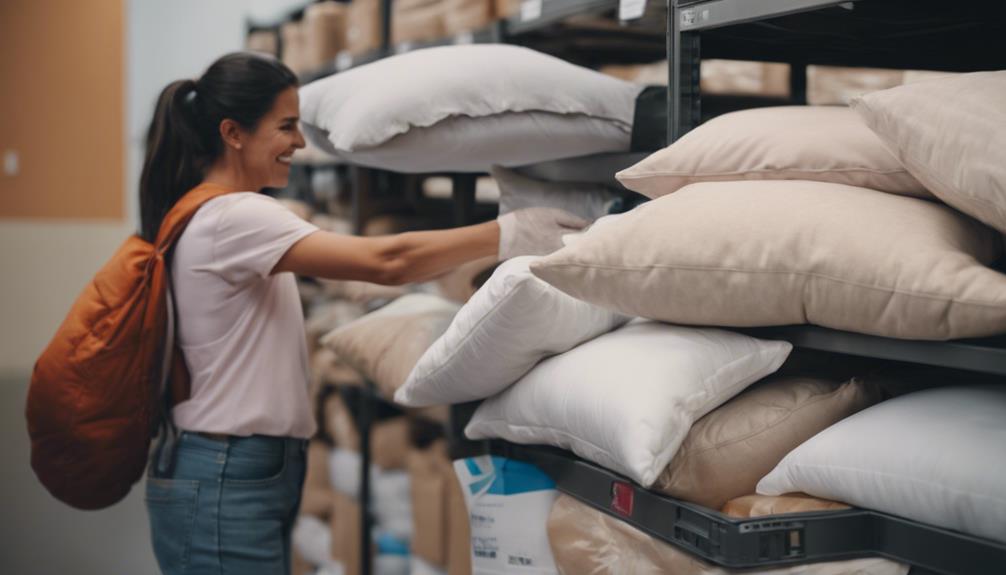
Donating old pillows responsibly involves researching local shelters, charities, and thrift stores for suitable donation opportunities. Many homeless shelters, animal shelters, and charities gladly accept clean and good condition old pillows for those in need. Additionally, some thrift stores, daycare facilities, and community centers may also welcome pillow donations. If your pillows are no longer suitable for donation, consider contacting textile recycling facilities to recycle them responsibly.
To guarantee your old pillows find a new home, reach out to organizations like Goodwill or The Salvation Army, as they often accept pillow donations. Another option is to upcycle old pillows by repurposing them into pet bedding or craft projects. Online platforms such as Freecycle and Craigslist can also help connect you with individuals or organizations in need of pillows. By donating or recycling your old pillows, you not only reduce waste but also provide essential bedding for those who require assistance.
The Environmental Impact of Throwing Away Pillows

When we throw away pillows, we contribute to the over 20 million pillows that end up in landfills annually, impacting the environment.
Synthetic pillows can take centuries to decompose, further exacerbating the waste issue.
Recycling pillows can mitigate this problem by repurposing them into insulation material, supporting sustainability efforts.
Pillow Filling Disposal
Tossing out pillows irresponsibly has a substantial impact on the environment due to their slow decomposition and contribution to landfill waste. Synthetic materials in pillow filling can take centuries to break down, adding to over 20 million pillows ending up in landfills yearly.
Recycling pillows is a sustainable solution, reducing waste and supporting the circular economy. Repurposing old pillows into insulation material further benefits the environment by giving them a new life beyond their initial use.
Proper disposal methods not only help decrease landfill waste but also promote sustainability practices for a healthier planet.
Recycling Options
Considering the significant environmental impact of throwing away pillows, exploring recycling options is essential for reducing waste and promoting sustainability.
Recycling old pillow stuffing helps minimize the over 20 million pillows that end up in landfills annually. Repurposing pillows into insulation material not only reduces waste but also provides an environmentally friendly alternative.
By upcycling and properly disposing of pillows through recycling, we can support the circular economy and lessen the burden on landfills. Recycled pillows offer a sustainable solution, as synthetic pillows can take centuries to decompose, affecting future generations.
Choosing to recycle pillows is a proactive step towards reducing waste accumulation and creating a more eco-conscious approach to pillow disposal.
Creative Ways to Upcycle Old Pillows

Interested in finding creative ways to give new life to your old pillows? Instead of throwing them away, consider upcycling them with these ideas:
- Floor Cushion Seats: Transform your old pillows into comfy floor cushions by sewing or wrapping them in a new fabric cover. Perfect for additional seating in your living room or a cozy reading nook.
- Pet Beds: Fill pillow protectors with your old pillow stuffing to create soft and cozy beds for your furry friends. They'll love lounging on a cushion made just for them.
- Draft Stoppers: Cut your old pillows to size and insert them into fabric tubes to block drafts from doors and windows. This energy-efficient solution helps maintain a comfortable temperature in your home while giving your pillows a new purpose.
With these creative ways to repurpose old pillows, you can avoid contributing to unnecessary waste and showcase your DIY skills by giving your pillows a second life in a useful and meaningful way.
Factors to Consider Before Disposing of Pillows

Before discarding pillows, it's crucial to assess their condition for signs of wear and tear like lumps, stains, or odors. Consider hygiene factors that affect your health, such as flattened padding or discolored fabric that may harbor allergens.
When getting rid of pillows, explore sustainable options like recycling, donating to shelters, or repurposing for creative DIY projects.
Pillow Condition Assessment
Evaluating the state of pillows before discarding them is essential to guarantee comfort and hygiene in your sleeping environment. When considering whether to dispose of a pillow, take note of the following factors:
- Shape and Support: Check for a flattened shape or loss of support, as these indicate the pillow may no longer provide proper comfort.
- Signs of Wear: Look for lumps, stains, tears, or odors that suggest the pillow is past its prime and could affect your sleep quality.
- Hygiene Concerns: Be mindful of allergens, dust mites, and overall cleanliness, as these can impact your health and well-being. If your pillow shows significant wear, tear, or hygiene issues, it's time to dispose of it responsibly.
Hygiene Considerations
Upon noticing signs of wear or hygiene concerns in pillows, it becomes essential to address these factors for better sleep quality and overall well-being. Pillows can harbor dust mites, allergens, and bacteria, impacting pillow hygiene.
Sweat, body oils, and dead skin cells accumulate over time, leading to hygiene concerns. Regularly washing pillows can help maintain hygiene and extend their lifespan. Stains, odors, or a flattened shape indicate the need to replace pillows due to hygiene issues.
Proper disposal of old pillows is vital to prevent hygiene risks and maintain a healthy sleeping environment. By being mindful of hygiene considerations, individuals can create a cleaner and more comfortable space for rest.
Sustainability Options
When considering sustainability options before disposing of pillows, it's important to prioritize recycling to reduce environmental waste. Here are key factors to keep in mind:
- Reduce Waste: Recycling old pillows can greatly decrease the amount of waste ending up in landfills.
- Environmental Conservation: Proper disposal through pillow recycling initiatives supports broader sustainability initiatives and helps protect the environment.
- Circular Economy: Repurposing pillows into recycled insulation material promotes a circular economy by giving new life to old products.
Recycling Options for Old Pillows

Considering the environmental impact of discarded pillows, exploring recycling options is essential for reducing waste and promoting sustainability. Over 20 million pillows end up in landfills each year, contributing to environmental harm.
Synthetic pillows can take centuries to decompose, emphasizing the long-term effects of improper disposal. Recycling old pillows not only reduces landfill waste but also supports sustainability by repurposing materials. These recycled pillows can be transformed into insulation material, giving them a second life and reducing the need for new resources.
Supporting recycling initiatives for old pillows is vital for promoting a circular economy and minimizing environmental impact. By choosing to recycle our old pillows, we can contribute to a more sustainable future and help combat the growing issue of waste accumulation.
Longevity of Pillows: When to Replace

To maintain peak comfort and support for a restful night's sleep, it's important to take into account the lifespan of your pillows. When it comes to pillow longevity, knowing when to replace them is essential to guarantee maximum comfort and hygiene. Here are some signs that indicate it's time for a pillow replacement:
- Shapelessness or Lumps: If your pillow no longer holds its shape or has noticeable lumps, it may no longer provide the support your neck and head need for a good night's sleep.
- Pain or Discomfort: Waking up with neck or back pain could be a sign that your pillow is no longer offering the right level of support.
- Stains, Tears, or Odors: Visible stains, tears, or unpleasant odors are indicators that your pillow is past its prime and may harbor allergens or bacteria.
When you notice these signs, it's time to dispose of old pillows properly and upgrade to new ones. Doing so can greatly improve your sleep quality and overall hygiene, ensuring you enjoy a comfortable and restorative night's sleep.
Frequently Asked Questions
Should You Throw Out Old Pillows?
When it comes to old pillows, it's important to think about discarding them if they show signs of wear like shapelessness, lumps, stains, tears, or odors. It's recommended to replace pillows every 1-2 years for hygiene reasons and best comfort.
Properly disposing of old pillows is essential to prevent them from adding to landfill waste. Recycling old pillows is a sustainable option to reduce environmental impact.
Upgrading pillows can enhance sleep quality and overall well-being.
Do Pillows Go in General Waste?
Pillows shouldn't be thrown into general waste bins due to their non-biodegradable nature. Materials like foam, polyester, or feathers used in pillows don't decompose easily in landfills, taking up valuable space and contributing to environmental pollution.
Recycling, donating to shelters, or repurposing old pillows are more vital options. Proper disposal methods are essential to minimize the negative impact on the environment.
How Long Should You Keep Pillows?
We typically recommend replacing pillows every 1-2 years for the best comfort and hygiene. Signs that it's time for a new pillow include shapelessness, lumps, stains, tears, or odors.
Regularly updating pillows can prevent neck and back pain and improve sleep quality. Properly disposing of old pillows is essential when they show wear and tear.
Upgrading to better pillows can enhance sleep by providing improved neck and back support.
Should You Wash or Throw Away Pillows?
We believe that washing pillows regularly is essential for extending their lifespan and maintaining hygiene. By doing this, you can reduce the need to throw them away.
However, if pillows are stained, lumpy, or causing discomfort, it might be time to replace them. Regular washing and proper care can help delay the need to dispose of pillows, ensuring they stay clean and comfortable for longer.
Should I Keep or Dispose of Old Throw Pillows?
If you’re wondering whether to keep or dispose of old throw pillows, consider creative ways to repurpose pillows. You can use them to make floor cushions, pet beds, or even a comforting quilt. Don’t just throw them away, think of imaginative ways to give them new life.
Conclusion
To sum up, throwing away old pillows may seem like the easiest option, but considering sustainable disposal methods and creative upcycling ideas can help reduce environmental impact. Donating or recycling old pillows can give them a new purpose and extend their lifespan.
So next time you're tempted to toss those pillows in the trash, think twice and explore alternative ways to give them a second life. Let's pillow talk about sustainability!
Decorative Throws
What Is the Point of a Throw on a Bed?
Jazz up your bed with a throw for added warmth and style, but there's more to discover – keep reading to uncover its full potential!
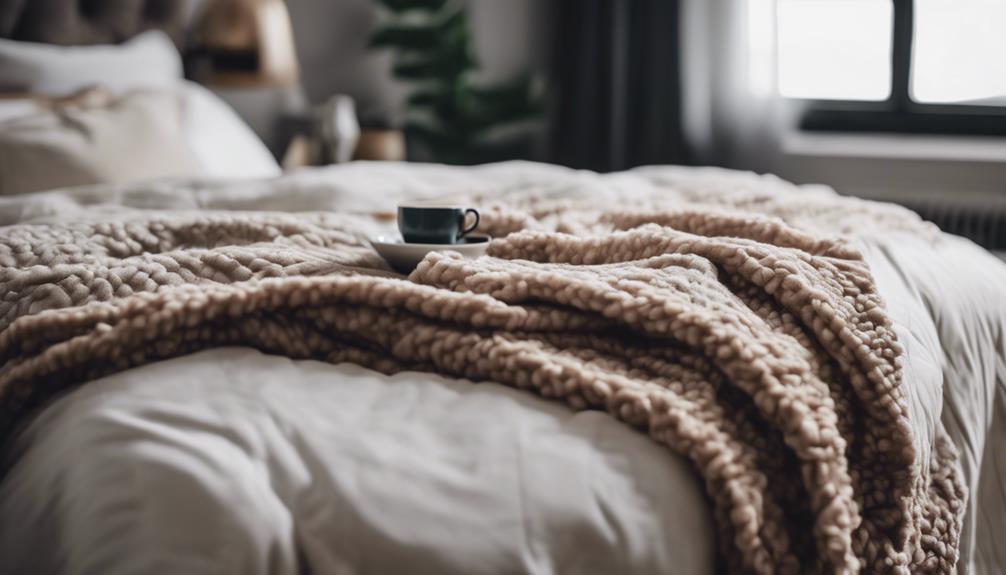
Adding a throw to your bed serves a dual purpose: getting cozy on cold nights and enhancing your bedroom decor with style. Whether you prefer luxurious silk or practical synthetic fibers, throws provide warmth and versatility. They enhance your decor by adding color, texture, and patterns seamlessly. Looking to protect your bedding from spills or switch up your room’s ambiance with the seasons? A throw has you covered. Discover more ways throws can elevate your bedroom oasis by learning about their aesthetic and practical benefits today!
Key Takeaways
- Adds extra warmth and comfort on chilly nights.
- Enhances bedroom decor with color and texture.
- Protects bedding from spills, stains, and wear.
- Easily updates room decor with different styles.
- Provides a quick and effortless room refresh.
Added Layer of Warmth
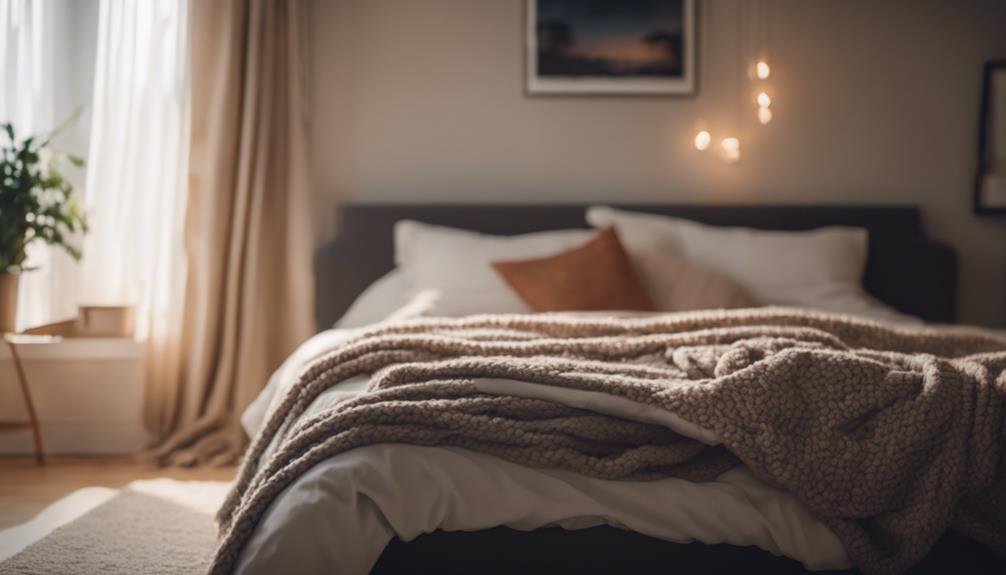
Adding a throw to your bed provides an extra layer of warmth, perfect for chilly nights without the bulk of a heavier blanket. Throw blankets are versatile additions that can be used to keep you cozy while lounging in bed, reading a book, or watching a movie. These throws come in a variety of materials, such as silk or man-made fibers, each offering unique benefits.
Silk throws are luxurious and soft, adding a touch of elegance to your bedding ensemble. On the other hand, man-made fiber throws are often more affordable and easier to care for, making them practical choices for everyday use.
Whether you prefer the silky smoothness of a silk throw or the easy maintenance of a man-made fiber throw, both options serve the purpose of providing that extra warmth you crave on colder nights. So, next time you're getting ready to snuggle up in bed, don't forget to grab your favorite throw to stay cozy and comfortable throughout the night.
Decorative Element for Bed
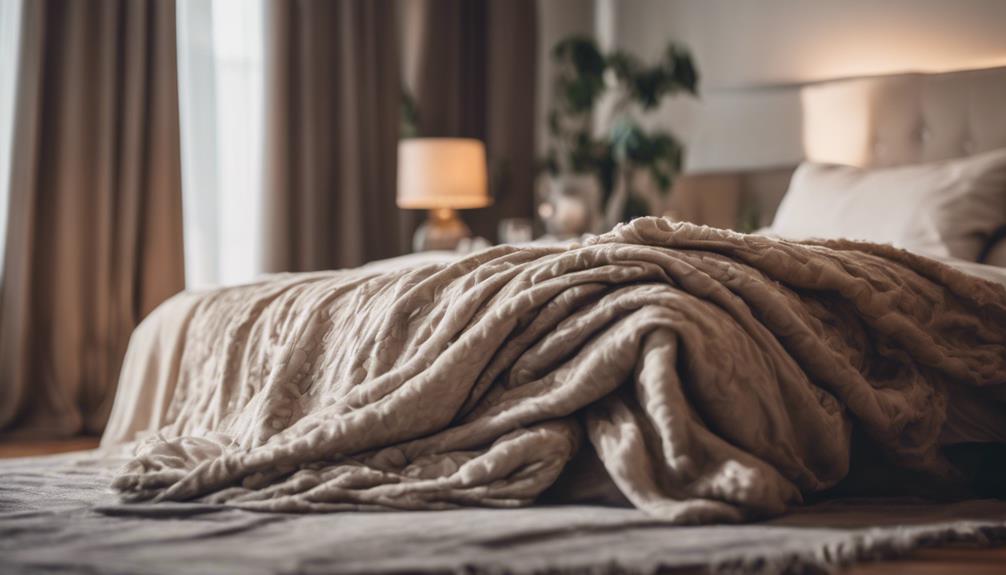
Adding a throw to your bed is like putting the cherry on top of a sundae – it brings the whole look together.
The colors and textures of the throw can add warmth and coziness to your bedroom, giving it a stylish layered appearance.
Bed Throw Colors
Enhancing the visual appeal of your bed, bed throw colors serve as a key decorative element that can tie together various aspects of your bedroom decor. They're often made from man-made fibers, with polyester being a popular fabric used for its durability and easy maintenance.
Bed throws come in a variety of colors, allowing you to choose shades that complement or contrast with your existing bedding and room decor. By selecting the right throw color, you can create a cohesive and harmonious design scheme in your bedroom.
Whether you opt for bold and vibrant hues to add a pop of color or prefer subtle tones for a more understated look, bed throw colors offer a quick and easy way to update the appearance of your bed without a major decor overhaul.
Texture Adds Warmth
Introducing a soft throw to your bed instantly infuses a touch of warmth and texture into your bedroom decor. Here are five reasons why adding a throw to your bed is a great idea, especially for summer:
- Throws with lightweight materials like cotton or linen are great for summer, providing just the right amount of warmth without overheating.
- The texture of a throw adds depth to your bedding ensemble, creating a cozy and inviting atmosphere in your bedroom.
- A throw can introduce a pop of color or a fun pattern to your bed, enhancing the overall look and feel of the space.
- Switching out throws is an easy way to refresh your bedding decor, allowing for quick and effortless updates to your bedroom's style.
- Personalize your bed with a throw that reflects your unique taste and preferences, adding a personal touch to your sanctuary.
Layering for Style
Layer your bed with a stylish throw to elevate the decor and create a cozy ambiance in your bedroom effortlessly. Adding a throw as a layer on your bed not only enhances the style of your bedding but also introduces color, texture, and pattern to the overall look. By incorporating a throw, you can easily refresh your bedroom decor without needing to completely change your bedding. This simple addition provides a warm and inviting atmosphere, perfect for relaxation. Additionally, using a throw as a finishing touch helps tie together the different elements of your bedding ensemble, resulting in a cohesive and well-designed space.
| Benefits of Layering a Throw on Your Bed |
|---|
| Adds decorative element |
| Introduces color, texture, and pattern |
| Easily refreshes bedroom decor |
Versatile Styling Option

When styling your bed, incorporating a throw offers a versatile option to effortlessly elevate the overall look. Throws on a bed can add a pop of color, texture, and pattern to the bedding ensemble. Here are five ways throws can enhance your bedroom decor:
- Color Splash: Choose a throw in a bold or contrasting color to make a statement and add visual interest to your bed.
- Texture Play: Opt for a throw with different textures like knits, faux fur, or woven patterns to create depth and coziness.
- Pattern Mix: Experiment with mixing patterns by layering a patterned throw over solid bedding for a trendy and eclectic look.
- Cozy Corner: Drape a throw over a corner of the bed to create a relaxed and inviting atmosphere, perfect for curling up with a book.
- Seasonal Switch: Easily update your bedroom decor by swapping out throws with seasonal colors or themes to keep your space feeling fresh and stylish.
Protection for Bedding
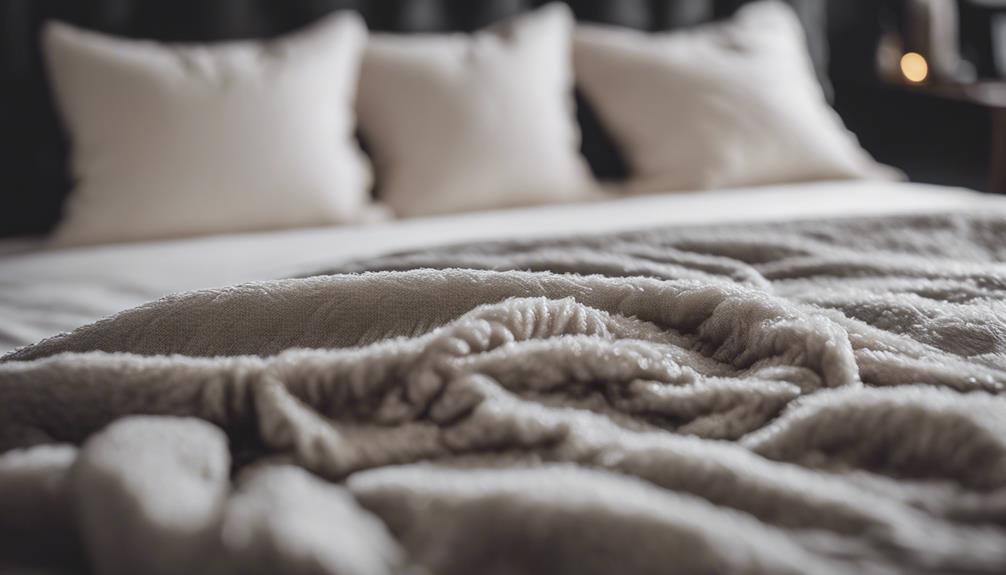
To safeguard your bedding against spills, stains, and pet hair, utilizing throws on your bed serves as a practical solution to extend the longevity of your duvets, blankets, and bedspreads. Throws act as a protective barrier, shielding your bedding from potential sources of dirt or damage. They make it easy to wash and maintain, ensuring your main bedding stays clean and fresh. By adding a throw to your bed, you add an extra layer of defense against wear and tear, preserving the appearance and quality of your bedding underneath.
Not only do throws protect your bedding, but they also prevent direct contact with oils, lotions, or other substances that may transfer from your body. This helps in maintaining the cleanliness of your duvets and blankets. Additionally, throws offer a convenient way to change the look of your bedroom easily and affordably. You can switch up the style or color of your throw to refresh your room's appearance while keeping your main bedding protected and in top condition.
Easy Room Refresh
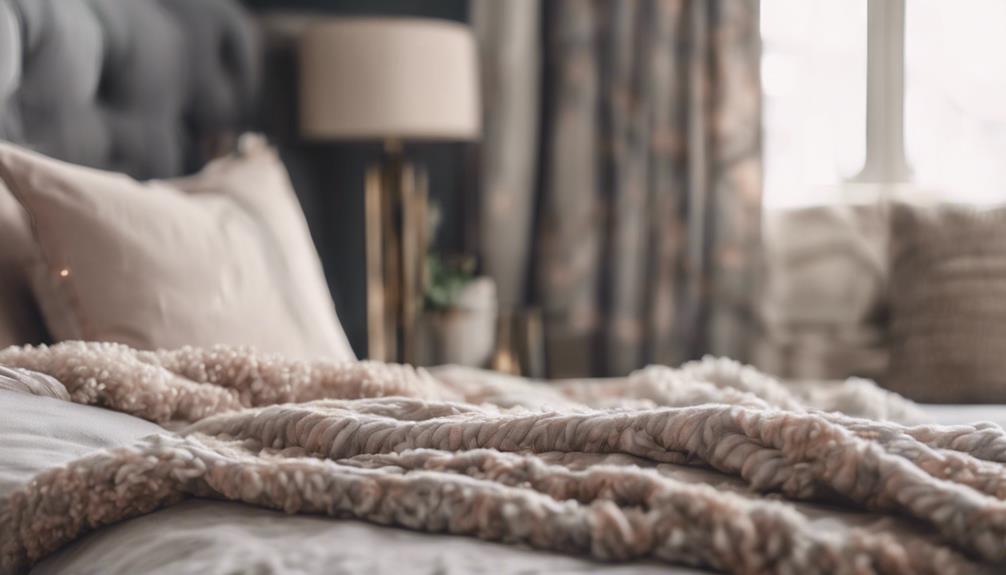
Adding a bed throw is like giving your room a mini makeover!
It's a simple way to switch up the look and feel of your space with little effort.
Decorative Accents for Bed
Enhance your bedroom decor effortlessly by incorporating bed throws as stylish decorative accents.
- Color Splash: Add a vibrant throw to inject a pop of color into your room.
- Texture Play: Choose a throw with a different texture to create visual interest.
- Pattern Mix: Opt for a throw with a bold pattern to liven up a neutral bedding set.
- Layering Magic: Layer different throws for a cozy and inviting look.
- Seasonal Switch: Easily update your bedroom's look with seasonal throws for a fresh feel throughout the year.
Quick Style Update
For a swift room makeover, consider incorporating bed throws to instantly liven up your space. Throws on a bed offer a quick and easy style update, adding a pop of color, texture, and warmth to your bedding ensemble.
They can be easily changed out to suit different seasons or design preferences, providing a versatile way to layer bedding and create a cozy atmosphere in your bedroom. By using a throw on your bed, you can enhance the overall aesthetic of the room in a simple yet effective manner.
Whether you prefer a bold statement piece or a subtle addition, bed throws are a fantastic way to refresh your room without a major overhaul.
Seasonal Coordination
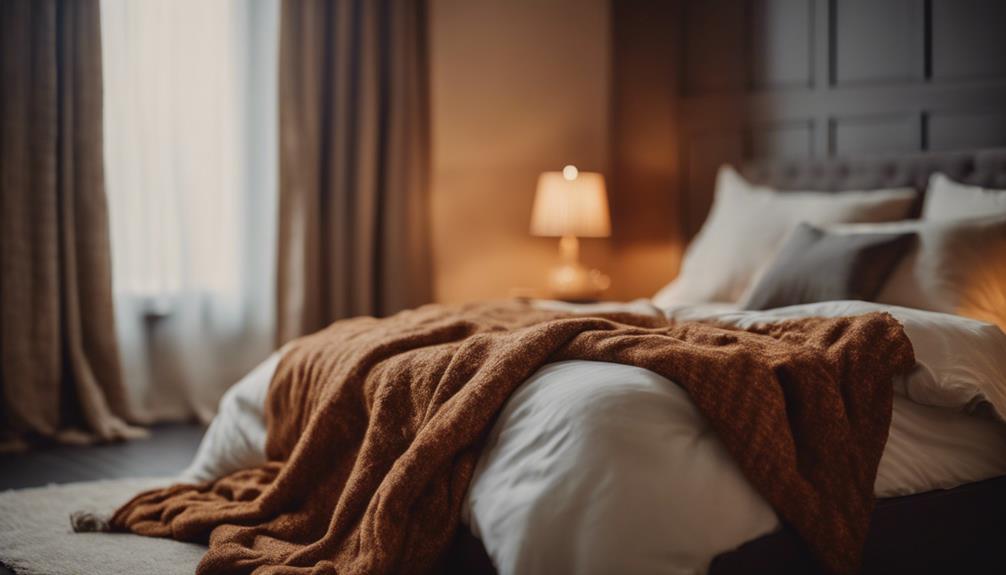
With seasonal coordination, bed throws can effortlessly transform the ambiance of your bedroom throughout the year. Here are five ways seasonal throw choices can enhance your bedroom decor:
- Switch Out Throws: Rotate between cozy, warm fabrics like wool or fleece for the colder months and lighter materials such as cotton or linen for a fresh look in summer.
- Match Changing Decor: Coordinate your throw with the evolving color scheme or theme in your bedroom to keep things looking cohesive.
- Add a Cozy Touch: Embrace thicker, warmer throws in the winter to create a snug and inviting atmosphere.
- Create a Breezy Look: Opt for lighter weight throws during warmer seasons to bring a sense of airiness and freshness to your bed.
- Easy Style Updates: By simply swapping out your throw, you can give your room a seasonal makeover without the need for a complete redesign.
Extended Bedding Lifespan
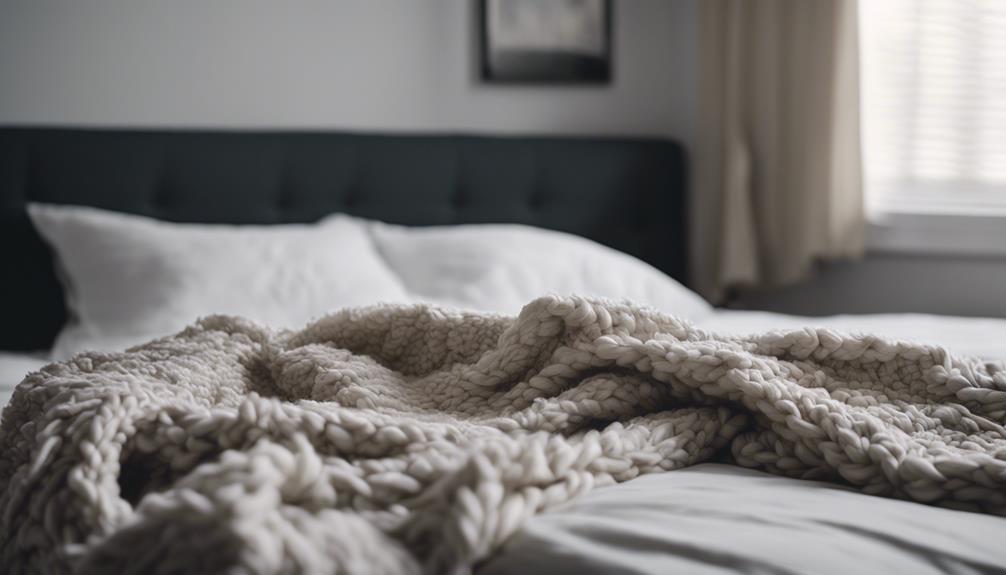
To extend the life of your bedding and protect it from spills and wear, consider using a throw on your bed. Throws play an important role in prolonging the lifespan of your bedding by acting as a shield against spills, stains, and the everyday wear and tear that bedding endures. They create a barrier between your body and the main bedding, reducing the need for frequent washing or dry cleaning of your main bedding items.
Additionally, throws offer a practical solution to easily switch up your bedroom decor without investing in new bedding sets. They can be washed or replaced effortlessly, providing a cost-effective way to refresh your bedroom style while preserving your main bedding.
In addition, throws add a layer of warmth and coziness during colder nights without adding extra bulk to your main bedding, ensuring both comfort and longevity for your bedding essentials. Incorporating a throw on your bed not only enhances the aesthetic appeal of your bedroom but also contributes to the practicality and durability of your bedding.
Fresh and Inviting Look

Adding a throw to your bed instantly elevates the room's ambiance with texture, color, and warmth. Here are five ways a throw can give your bed a fresh and inviting look:
- Texture: Throws come in various materials like soft fleece, cozy knit, or luxurious faux fur, adding depth and tactile appeal to your bed.
- Color: Choose a throw in a hue that complements your bedding or adds a pop of color to create a focal point in the room.
- Warmth: During colder months, a throw not only adds visual interest but also provides an extra layer of warmth for chilly nights.
- Style Update: Easily switch out throws to match different seasons or update your room's style without the need for a complete bedroom makeover.
- Cozy Atmosphere: Draping a throw casually over the corner of the bed creates a cozy and inviting feel, making your bed more welcoming and comfortable.
Frequently Asked Questions
Why Do You Need a Throw Blanket?
Why do you need a throw blanket?
Throws aren't only cozy additions to your bed; they also offer quick style updates for your room. Providing a splash of color or texture, they elevate your bedroom decor effortlessly. Plus, throws are versatile – perfect for snuggling up with a book or binge-watching your favorite show.
They serve a practical purpose too, safeguarding your bedding from spills and pet hair. So, why not add a throw to your bed for both comfort and flair?
Do You Sleep With a Throw Blanket?
Yes, you do sleep with a throw blanket. It's a cozy addition to your bedding, offering warmth and style.
Whether for extra comfort or as a decorative touch, a throw blanket can enhance your sleep experience. Its versatility allows for adjusting warmth levels to suit your preference.
Why Do People Use Throws?
When you think about why people use throws, the answer is clear: versatility. Throws provide an effortless way to update your bedroom's style without breaking the bank.
They offer a layer of warmth and comfort while adding a decorative touch to your bedding. Plus, throws help protect your bedspread from spills and stains.
What Is the Purpose of a Bed Spread?
A bedspread serves as both a practical and stylish addition to your bed. It covers the entire bed, including pillows, adding a decorative touch to your bedroom.
Bedspreads are lightweight and quilted, perfect for warmer nights when you want a bit of extra coverage without overheating. They come in various designs and fabrics, allowing you to easily change the look of your room and make a statement with your bedding choice.
How Does a Throw Pillow Serve a Purpose on a Bed?
When it comes to the size of throw pillows for a queen bed, it’s all about adding visual interest and comfort. These pillows can provide support while sitting up in bed, and create a layered, inviting look when paired with larger bed pillows. They serve as both functional and decorative elements in the bedroom.
Conclusion
So, the next time you're wondering about the point of a throw on a bed, remember all the benefits it brings!
From adding an extra layer of warmth to protecting your bedding and giving your room a fresh look, throws aren't just decorative but also practical.
So why not try adding one to your bed and see how it can elevate your space?
Who knew a simple throw could make such a difference!
Decorative Throws
Dry Cleaning Throw Pillows
Leverage professional dry cleaning services for your throw pillows to safeguard delicate fabrics and intricate designs.
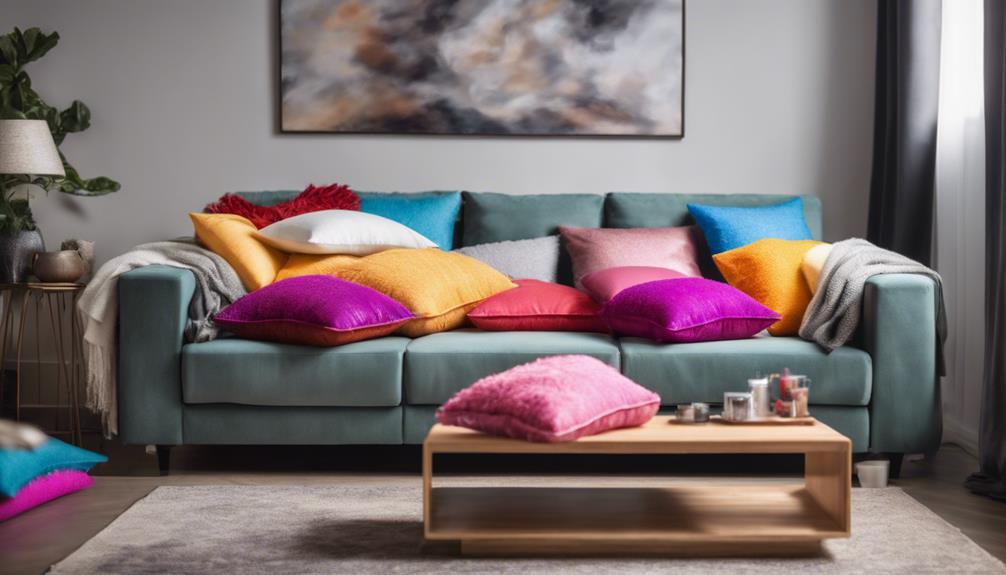
Dry cleaning throw pillows is essential for preserving delicate fabrics, intricate designs, and extending their lifespan. It is ideal for non-removable covers or detailed throw pillows. Dry cleaning provides convenience with pickup and delivery options, utilizing gentle specialized products to protect the unique characteristics of the pillows. Fabrics such as silk, wool, leather, and suede benefit greatly from this method. Professionals are able to effectively handle tough stains, ensuring a thorough cleaning process without causing any damage. Opting for professional services helps to prevent DIY mishaps and ensures expert care for delicate fabrics. Learn more about the suitable fabrics, when to choose dry cleaning, and the benefits it offers for your throw pillows.
Key Takeaways
- Preserves delicate fabrics and intricate designs
- Suitable for non-removable covers or special finishes
- Specialized products for silk, wool, suede, and leather
- Effective for tough stains and odors on high-maintenance fabrics
- Extends the lifespan of throw pillows
Benefits of Dry Cleaning Throw Pillows
Dry cleaning throw pillows enhances their longevity by preserving delicate fabrics and intricate designs effectively. When it comes to cleaning throw pillows, especially those with non-removable covers or intricate details, opting for professional dry cleaning services can be a wise choice. Professional dry cleaners possess the expertise to handle tough stains and intricate cleaning processes, guaranteeing that your throw pillows remain in top condition.
One of the key benefits of dry cleaning throw pillows is the convenience it offers. With pickup and delivery options available from dry cleaning services, busy individuals can easily maintain the cleanliness of their throw pillows without added hassle. Additionally, the specialized products used in dry cleaning are gentle on delicate fabrics, safeguarding the quality and shape of the pillows over time. This gentle approach not only ensures cleanliness but also helps in preserving the unique features of your throw pillows, making dry cleaning a valuable investment in their upkeep.
Suitable Fabrics for Dry Cleaning
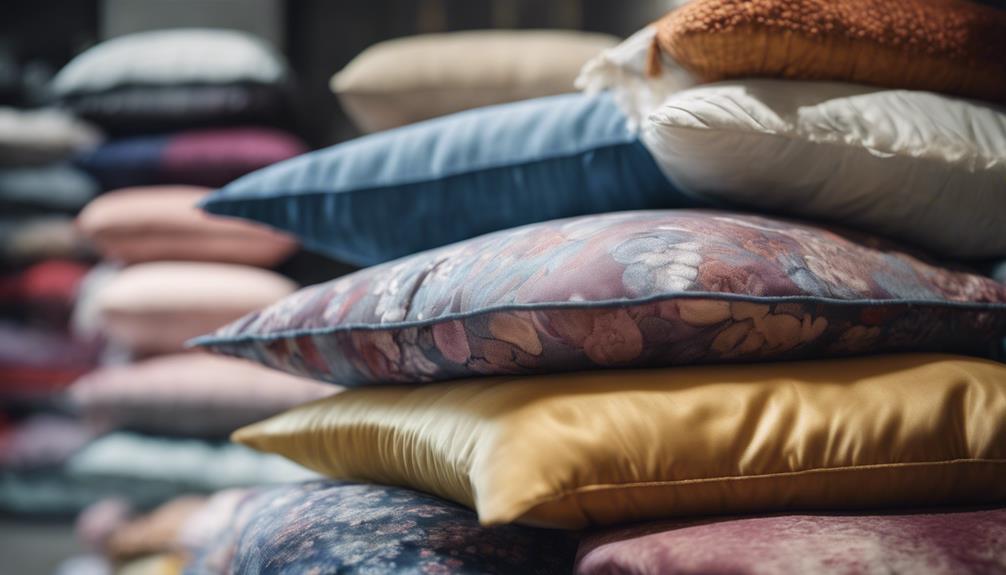
Certain fabrics like silk, wool, leather, and suede are ideal for dry cleaning as it helps preserve their quality and texture.
Dry cleaning is especially recommended for delicate materials that may shrink, distort, or fade when washed with water-based methods.
Dry cleaners have the necessary expertise and equipment to safely handle intricate fabrics such as velvet, lace, and beaded materials.
Fabric Types
Silk, wool, and velvet are among the fabric types that are suitable for professional dry cleaning to prevent damage and maintain their quality. When it comes to delicate fabrics, turning to professional dry cleaners is essential to ensure the preservation of their integrity. These experts have the know-how to handle intricate designs and embellishments with care.
Moreover, dry cleaning is highly recommended for fabrics like leather or suede to maintain their texture and appearance. Professional dry cleaners employ specialized techniques that are safe for fabrics such as silk, satin, and cashmere.
In addition, dry cleaning is effective in removing tough stains and odors from high-maintenance fabrics, ensuring they look their best for longer.
Dry Cleaning Methods
When considering the appropriate fabrics for professional dry cleaning methods, it's important to prioritize the preservation of delicate textures and intricate designs. Delicate fabrics such as silk, leather, suede, and wool are well-suited for dry cleaning, safeguarding their longevity.
Professional dry cleaners have the expertise and specialized products to address tough stains on throw pillows effectively. For water-based stains, products like Dryel can be a convenient at-home solution. Antique throw pillows or those with intricate embellishments benefit from dry cleaning to maintain their quality over time.
It's advisable to avoid spot-cleaning delicate embellishments on throw pillows, as this can lead to damage. Trusting professional dry cleaners for such delicate fabrics ensures thorough cleaning while preserving the integrity of the throw pillows.
When to Opt for Dry Cleaning
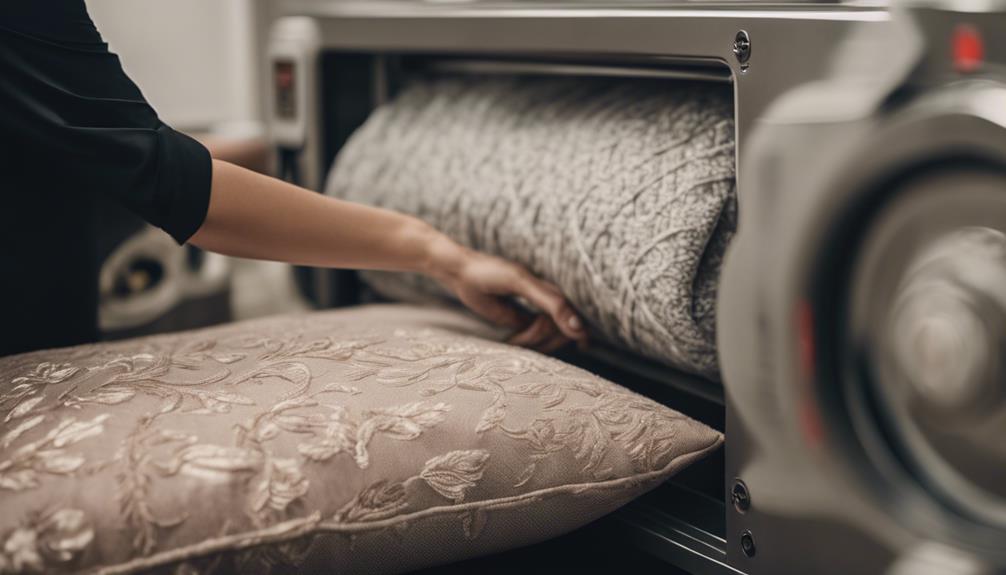
Regularly choosing dry cleaning for delicate throw pillows made of silk, wool, suede, or leather helps preserve their quality and appearance. When deciding whether to opt for dry cleaning, consider the fabric type and any intricate embellishments. It's advisable to choose dry cleaning for throw pillows with special finishes to prevent damage during washing. Tough stains on these delicate throw pillows may necessitate professional dry cleaning services for effective removal. Dry cleaning not only helps maintain the shape and quality of decorative throw pillows but also ensures that the delicate fabrics are handled with care. Professional dry cleaners possess specialized products and techniques tailored to the specific needs of silk, wool, suede, and leather throw pillows.
- Dry cleaning is recommended for delicate throw pillows.
- Consider fabric type and embellishments before opting for dry cleaning.
- Choose dry cleaning for throw pillows with special finishes.
- Tough stains may require professional dry cleaning services.
- Professional dry cleaners have specialized products for silk, wool, suede, and leather.
Professional Vs. DIY Dry Cleaning
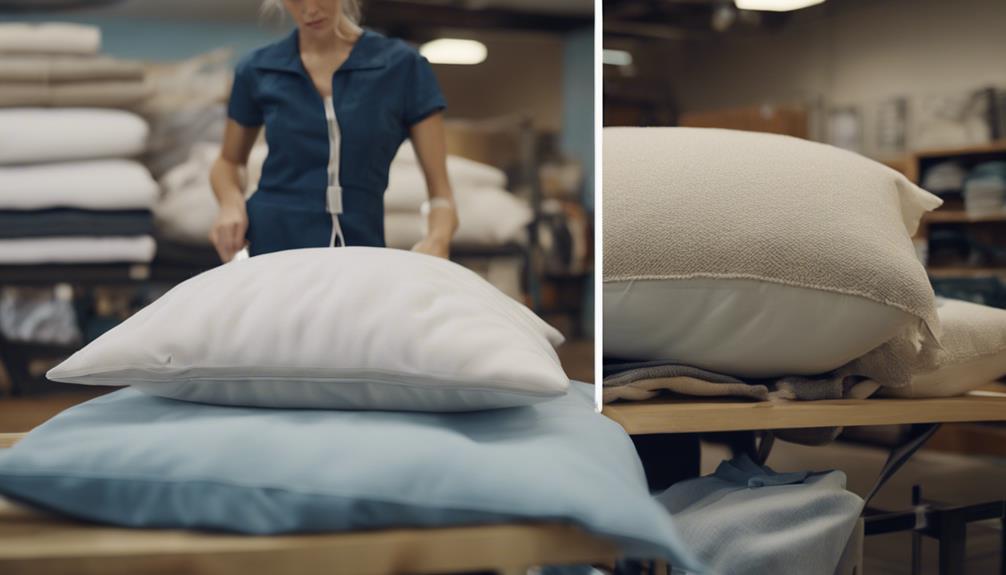
When deciding between professional and DIY dry cleaning for throw pillows, it's important to weigh the trade-off between cost-effectiveness and time-saving benefits.
Professional dry cleaning services offer specialized techniques tailored to delicate fabrics, ensuring effective stain removal and preservation of intricate embellishments.
While DIY methods may seem more budget-friendly, the risk of damaging valuable throw pillows that require professional care is a key factor to take into account.
Cost-Effective Dry Cleaning
For cost-effective dry cleaning of throw pillows, comparing professional services to DIY kits is essential to determine the best option for your needs. Professional dry cleaning can range from $15 to $50 per pillow, depending on the fabric and size, while DIY kits like Dryel offer a more budget-friendly solution at around $10 for a starter kit.
Professional services provide specialized treatments for delicate fabrics like silk, wool, or leather, ensuring proper fabric care and maintenance. On the other hand, DIY dry cleaning kits are designed for home use with specific instructions to safely clean and refresh throw pillows without the need for professional services.
While professional dry cleaning may offer more thorough results, DIY dry cleaning can be a convenient and cost-effective option for routine pillow maintenance.
- Professional dry cleaning cost: $15 to $50 per pillow
- DIY dry cleaning kits cost: around $10 for starter kit
- Professional services offer specialized treatments for delicate fabrics
- DIY kits designed for home use with specific instructions
- DIY dry cleaning is a budget-friendly option for routine maintenance
Time-Saving Professional Services
Comparing professional dry cleaning services to DIY kits for throw pillows reveals the time-saving advantages of opting for expert care. Professional dry cleaners possess the expertise and resources to effectively clean and maintain the shape and quality of various types of throw pillows. They guarantee proper care for delicate or special fabric pillows, preventing potential damage.
Additionally, professional services offer convenient pickup and delivery options, making the process hassle-free for users. When dealing with bulky or hard-to-clean throw pillows, relying on professional dry cleaning is recommended for safe and efficient cleaning methods. By choosing professional dry cleaning services, users can save time and effort while ensuring their throw pillows receive the care and attention they deserve.
Dry Cleaning Process Explained
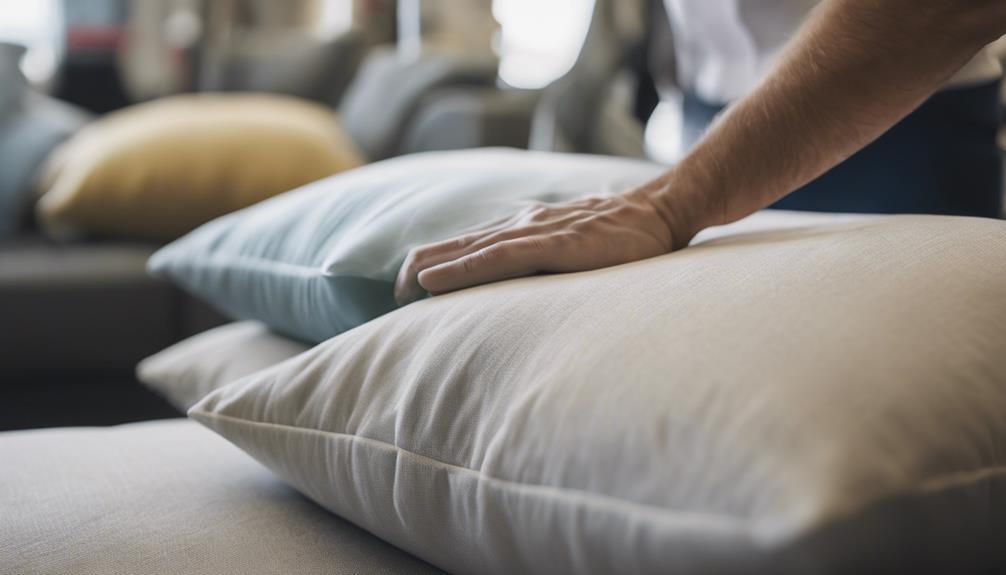
Exploring the dry cleaning process for throw pillows reveals a meticulous method that safeguards their delicate fabrics and intricate designs. When it comes to dry cleaning high-quality pillows with special fabrics, professional cleaners employ a series of steps to guarantee a thorough and gentle cleaning process. Here's how the dry cleaning process for throw pillows is typically carried out:
- Assessment: Professional cleaners examine the pillow for stains and dirt, identifying any special care instructions for delicate materials.
- Pre-Treatment: Stubborn stains are targeted with specialized solutions to help loosen and lift them from the fabric.
- Cleaning: The pillow is placed in a dry cleaning machine where chemical solvents are used to clean without water, preserving the integrity of the delicate materials.
- Drying: After cleaning, the pillow is dried using controlled methods to prevent damage and ensure thorough drying.
- Finishing: The pillow is carefully inspected, pressed if necessary, and packaged to maintain its freshness until collection.
Stain Removal With Dry Cleaning
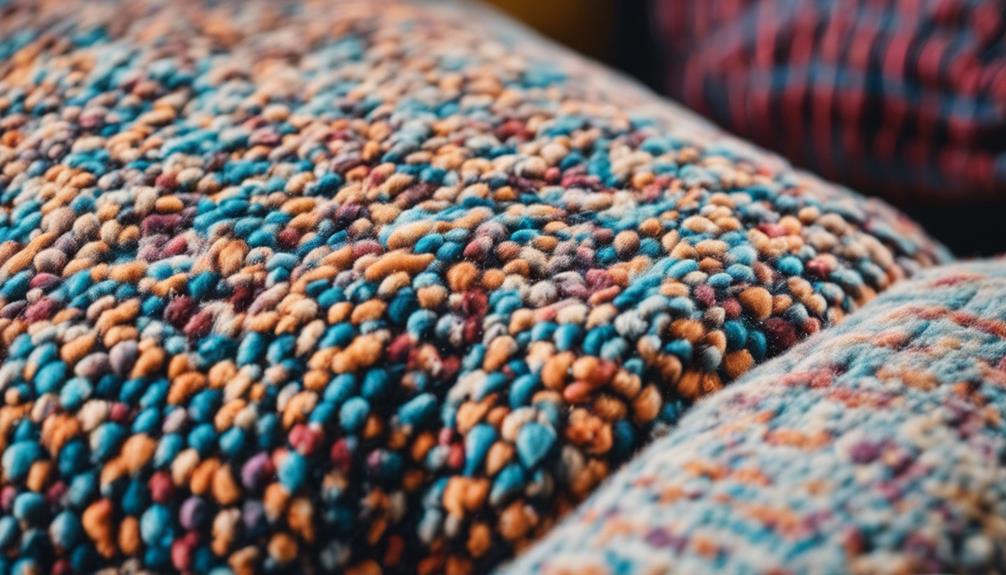
When addressing tough stains on throw pillows, utilizing dry cleaning proves to be a reliable method for effective removal.
Professional dry cleaners have the expertise and specialized products to tackle challenging stains, including oil-based ones that may be difficult to remove with traditional washing methods.
Dry cleaning is particularly beneficial for delicate fabrics or throw pillows with intricate designs that could be damaged by regular washing.
Dry Cleaning for Delicate Pillows
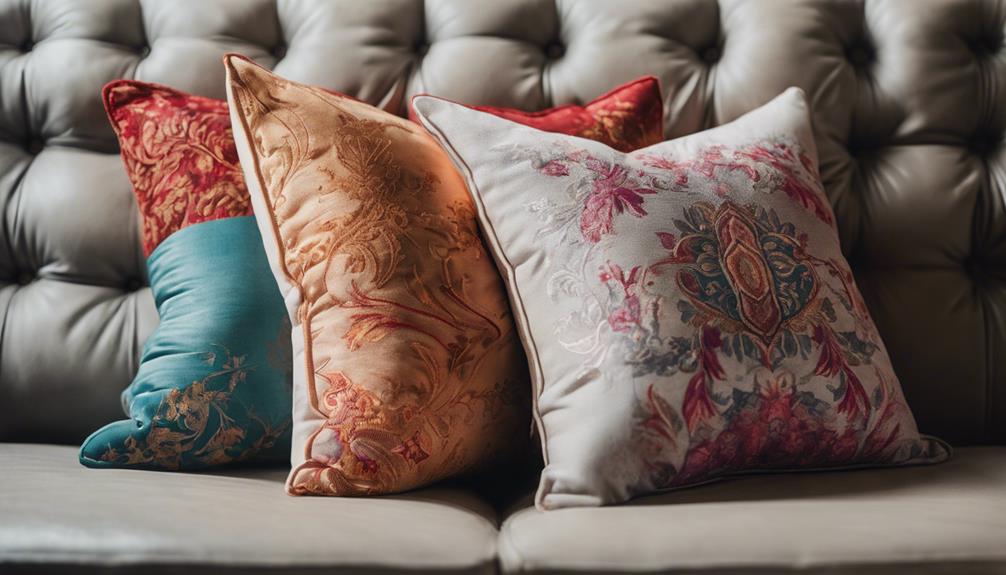
Dry cleaning is highly recommended for delicate throw pillows made of special fabrics such as silk, leather, suede, or wool to prevent damage during washing. Professional dry cleaners have the expertise and products to safely clean and maintain the quality of delicate pillows. Dry cleaning services can effectively remove tough stains and odors from non-machine washable pillows. It's advisable to avoid spot-cleaning delicate embellishments on throw pillows and opt for dry cleaning to preserve their intricate details. Dry cleaning offers a convenient solution for maintaining the shape and cleanliness of delicate or special fabric throw pillows.
- Professional dry cleaners ensure safe cleaning for delicate pillows
- Dry cleaning effectively removes tough stains and odors
- Opting for dry cleaning preserves intricate details on delicate pillows
- Dry cleaning is a convenient solution for non-machine washable pillows
- Maintains the shape and quality of special fabric throw pillows
Extending Pillow Lifespan
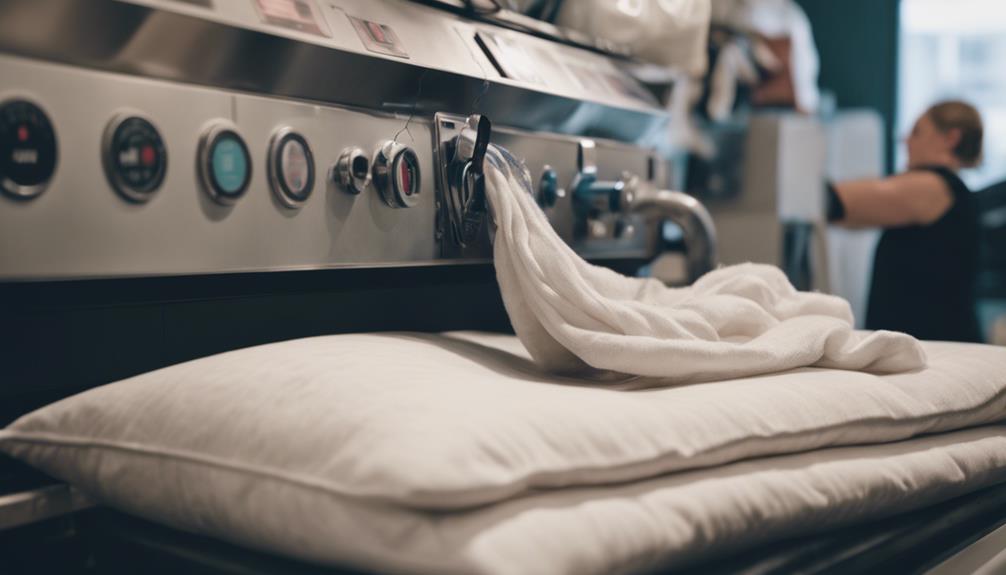
To maximize the longevity of delicate or special fabric throw pillows, professional dry cleaning services play a key role in preserving their quality and appearance. By entrusting your throw pillows to specialized cleaners, you can ensure they receive the proper care needed to extend their lifespan. Improper washing techniques at home can lead to damage, making professional cleaning a wise choice for delicate fabrics. These experts have the knowledge and tools to handle intricate cleaning processes, maintaining the shape and quality of your throw pillows. Additionally, the convenience of professional cleaning services, which may include pickup and delivery options, makes caring for your pillows a hassle-free experience. Investing in professional dry cleaning not only ensures the cleanliness of your throw pillows but also contributes to their longevity, allowing you to enjoy their beauty for years to come.
| Benefits of Professional Dry Cleaning | |
|---|---|
| Extends Pillow Lifespan | |
| Prevents Damage from Improper Washing | |
| Maintains Shape and Quality | |
| Expertise in Handling Delicate Fabrics | |
| Convenient Pickup and Delivery Options |
Frequently Asked Questions
Can a Dry Cleaner Clean a Pillow?
Yes, a dry cleaner can clean a pillow. We use specialized products to clean non-removable covers and delicate fabrics effectively.
Dry cleaning helps maintain the pillow's shape and quality while tackling tough stains and odors. Our services offer convenience with pickup and delivery options.
Trust us to handle your pillows with care and guarantee they come back fresh and clean.
Are Pillows Worth Dry Cleaning?
Dry cleaning pillows can be worth it for delicate or special fabric pillows that may be damaged by regular washing methods. It helps maintain the shape and quality of throw pillows with intricate designs or embellishments.
Professional cleaners have the expertise to handle tough stains and maintain the integrity of the pillows. Additionally, dry cleaning services offer convenience with pickup and delivery options for hassle-free pillow cleaning.
Ultimately, for antique or valuable throw pillows, dry cleaning is a safe and effective way to preserve their condition.
What Is the Best Way to Clean Throw Pillows?
When cleaning throw pillows, the best way depends on the material and design. For delicate or intricate pillows, dry cleaning is ideal. It's professional, using specialized solvents that guarantee shape, quality, and color without risking damage.
Experts provide tailored solutions, preserving the integrity of decorative or specialty pillows. Opting for dry cleaning guarantees thorough cleaning while protecting your investment. It's a smart choice for maintaining the beauty and longevity of your throw pillows.
Can You Get Couch Pillows Dry-Cleaned?
Yes, couch pillows can be dry-cleaned. It's a suitable method for delicate or non-removable covers that could get damaged in a regular wash. Professional dry cleaners have the skills and tools to handle various pillow types safely.
Dry cleaning effectively removes tough stains and odors. It's a convenient way to maintain and care for your pillows, ensuring they stay in good condition.
Conclusion
To sum up, dry cleaning throw pillows can help maintain their appearance and extend their lifespan.
Did you know that on average, a throw pillow should be cleaned every 3-6 months to prevent dirt and dust buildup?
By choosing the right fabrics, knowing when to opt for dry cleaning, and understanding the process, you can keep your throw pillows looking fresh and clean for years to come.
Consider dry cleaning as a convenient option for your home decor maintenance.
Decorative Throws
What Is the Best Material for a Couch Throw Blanket?
Uncover the ultimate material for your couch throw blanket to elevate your comfort and style – discover the perfect choice within our detailed guide.
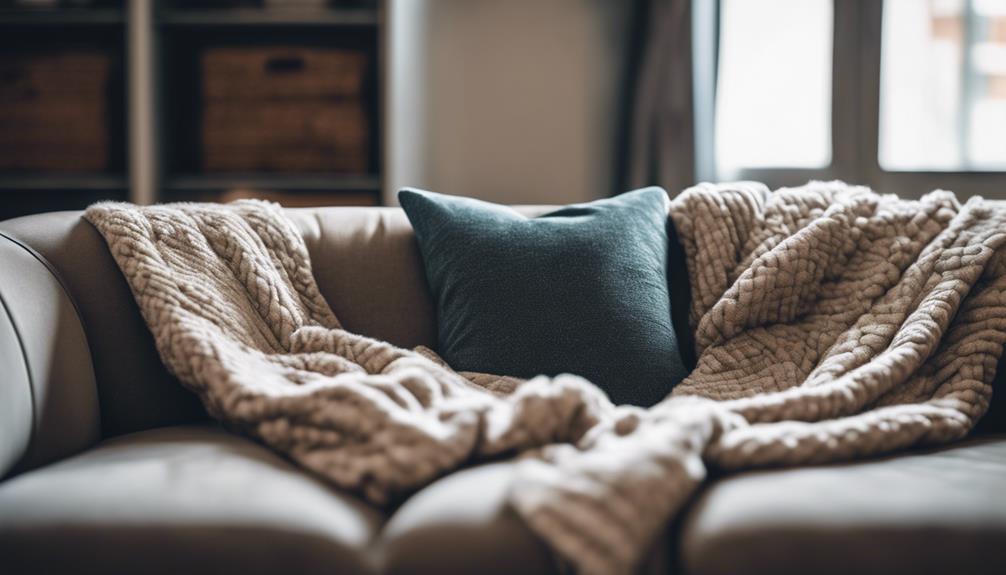
When selecting a material for a couch throw blanket, it’s important to consider factors like durability, comfort, and maintenance to ensure lasting coziness and style. Fleece is soft, warm, and machine washable, but less breathable than natural fibers. Sherpa offers luxurious warmth, easy care, and stylish texture. Acrylic, nylon, and polyester are durable and versatile options. Wool stands out for resilience and shape maintenance, making it ideal for longevity. Cotton is breathable and hypoallergenic, while wool provides warmth and fire resistance. Fleece is warm, sturdy, and wrinkle-resistant. Each material brings unique benefits to your couch throw blanket, ensuring comfort and durability. Additional insights can be found in our detailed guide.
Key Takeaways
- Wool: high durability, warmth, and natural resilience.
- Fleece: soft, cozy, and machine-washable for easy care.
- Cotton: breathable, soft, and hypoallergenic.
- Acrylic: durable, lightweight, and affordable.
- Sherpa: luxurious coziness, warmth, and stylish texture.
Popular Couch Throw Blanket Materials
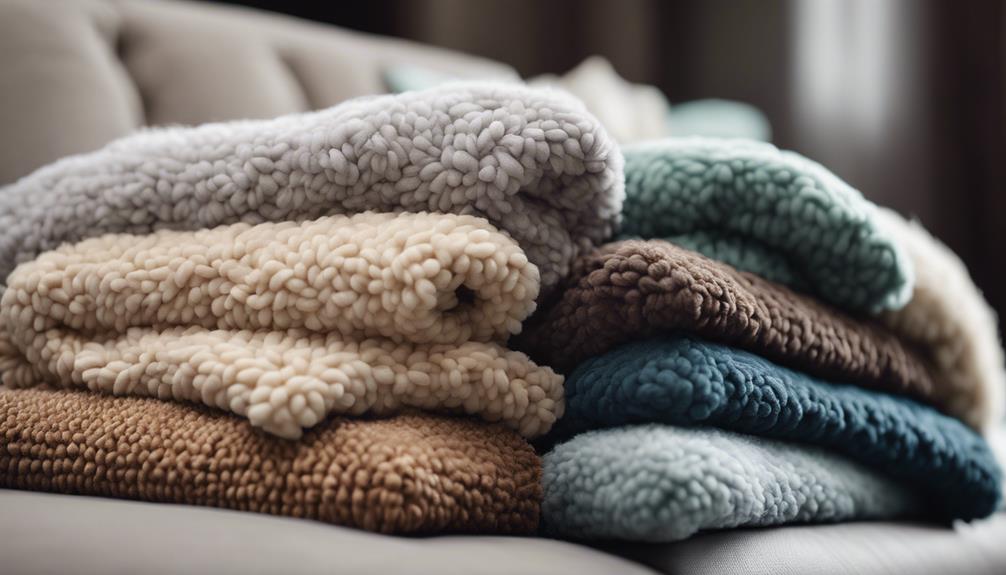
When choosing a couch throw blanket material, consider the popular options like fleece, cotton, acrylic, chenille, and faux fur for their unique qualities.
Throws made of fleece are favored for their super soft, lightweight, and extra warm properties, making them perfect for snuggling up on the couch.
Cotton blankets offer a soft, breathable, and long-lasting option that provides both comfort and versatility, ideal for all seasons.
Acrylic throws are known for their durability and affordability, making them a practical choice for everyday use.
Chenille blankets bring a touch of luxury with their velvety texture, adding elegance to any couch.
Faux fur throws provide a plush and cozy feel, perfect for adding warmth and style to your living space.
Each material offers its own set of benefits, so choose the one that best suits your comfort preferences and aesthetic desires.
Factors to Consider When Choosing Material
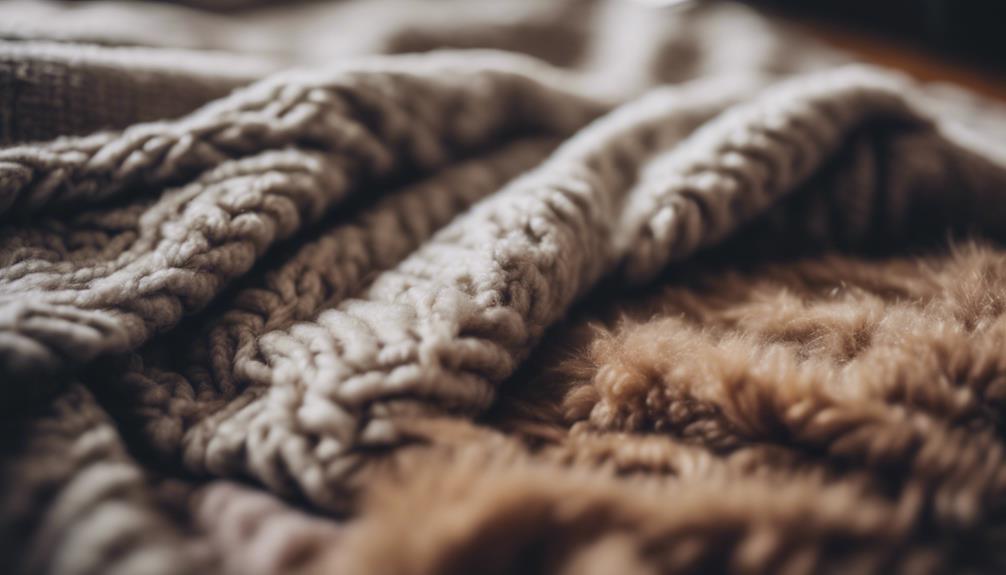
Considering the level of warmth required and the ease of maintenance, it is essential to evaluate the durability and comfort of various materials when selecting a couch throw blanket. Below is a comparison table to help you make an informed decision:
| Material | Durability | Comfort | Maintenance |
|---|---|---|---|
| Wool | High | Warm | Dry clean |
| Fleece | Medium | Soft | Machine wash |
| Cotton | Low | Breathable | Easy care |
| Synthetic | Varies | Cozy | Machine wash |
When choosing a material, consider how often the blanket will be used and what kind of feel you prefer. Wool offers excellent durability and warmth but may require extra care. Fleece provides softness and is easy to clean, making it a practical choice for everyday use. Cotton is breathable and hypoallergenic, perfect for those with sensitivities. Synthetic materials come in a variety of textures, offering a cozy feel without the high maintenance of wool. By weighing these factors, you can find the perfect couch throw blanket material to suit your needs.
Pros and Cons of Fleece
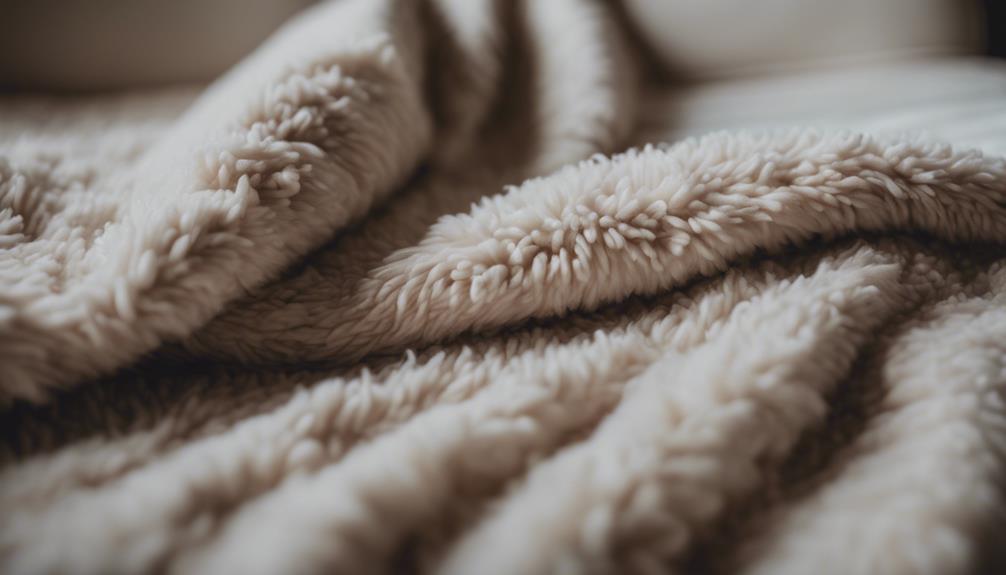
Fleece throw blankets offer a super soft and lightweight option for extra warmth, making them a popular choice for cozying up. Here are some pros and cons of fleece blankets:
- Soft and Cozy: Fleece blankets, made of acrylic fibers, are known for their softness and coziness, providing a comfortable experience for snuggling.
- Insulating and Durable: The insulating properties of fleece make it a great choice for keeping you warm, while its durability guarantees long-lasting use, making it practical for everyday use.
- Machine Washable: Fleece is easy to care for as it's machine washable, allowing for convenient cleaning and maintenance.
While fleece blankets have numerous benefits, one potential downside is that they may be less breathable compared to natural materials like cotton or wool.
The Benefits of Sherpa Material
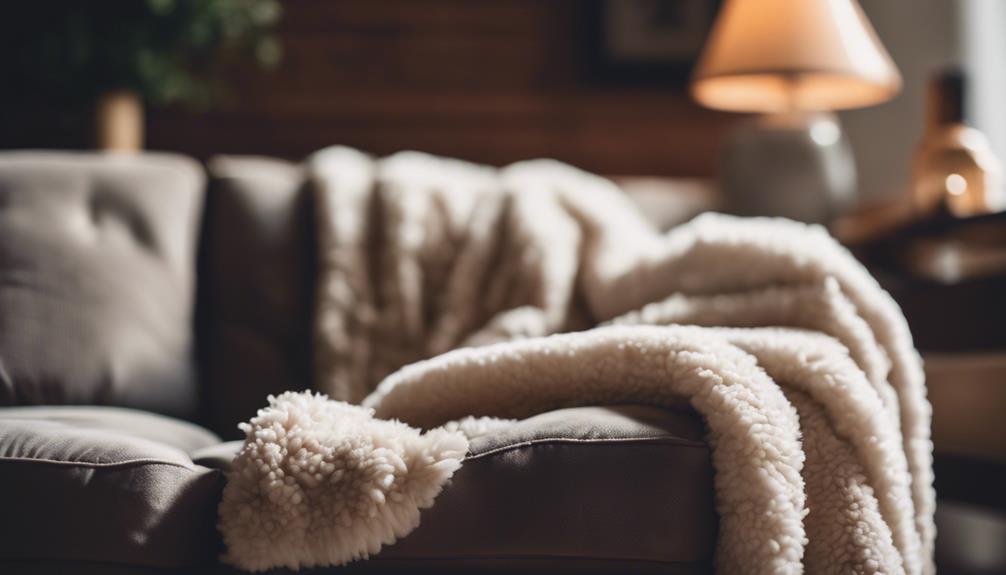
Sherpa material exudes a luxurious coziness that enhances the comfort of a couch throw blanket. Sherpa blankets are renowned for their softness and warmth, providing a cozy and snug feel that's perfect for chilly evenings. Made from polyester or a blend of polyester and acrylic fibers, sherpa guarantees durability and easy maintenance, ensuring long-lasting use.
Its lightweight yet insulating nature offers a comfortable and cozy experience without feeling too heavy or cumbersome. Additionally, the stylish texture of sherpa adds an inviting touch to your couch throw blanket, enhancing the overall look and feel of your living space.
Whether you're snuggled up with a good book or enjoying a movie night, a sherpa blanket combines practicality with luxury, making it a versatile and desirable choice for those seeking both comfort and style in their home decor.
Exploring Acrylic, Nylon, and Polyester
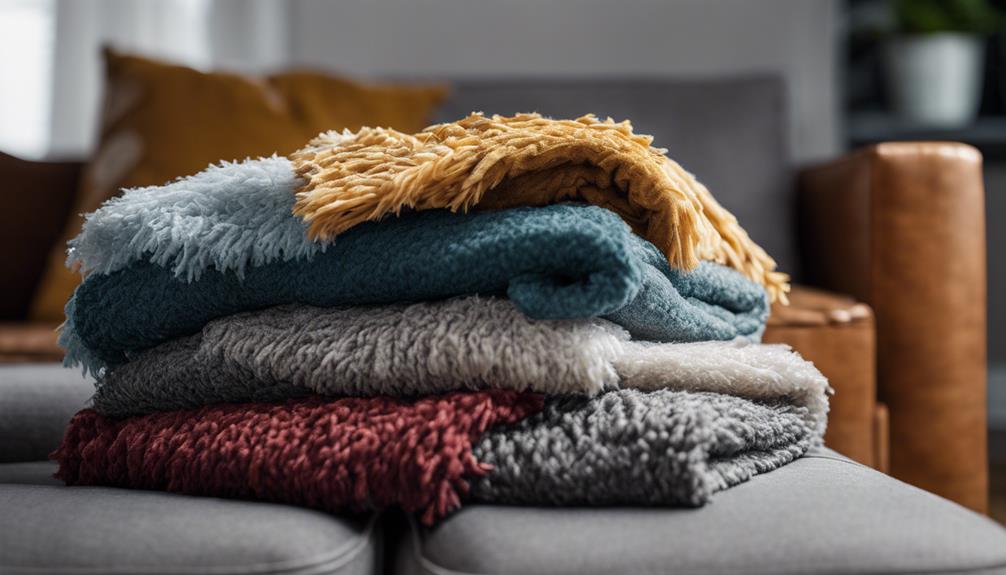
Moving on from the benefits of sherpa material, acrylic, nylon, and polyester offer a diverse range of qualities for couch throw blankets.
- Acrylic throw blankets are known for their softness, lightweight feel, and durability, making them a popular choice for everyday use on a couch.
- Nylon throw blankets strike a balance between strength and softness, providing a cozy feel while being resistant to wear and tear, ensuring longevity in your living space.
- Polyester throw blankets aren't only affordable but also easy to care for, coming in a wide array of colors and patterns to suit various decor styles, offering both versatility and style to your couch setting.
Acrylic fibers in throw blankets imitate the softness of wool without the itchiness, providing a comfortable option for snuggling. Nylon and polyester blend throw blankets merge the softness of nylon with the affordability and easy care of polyester, creating a versatile and practical choice for couch throws.
Best Material for Longevity
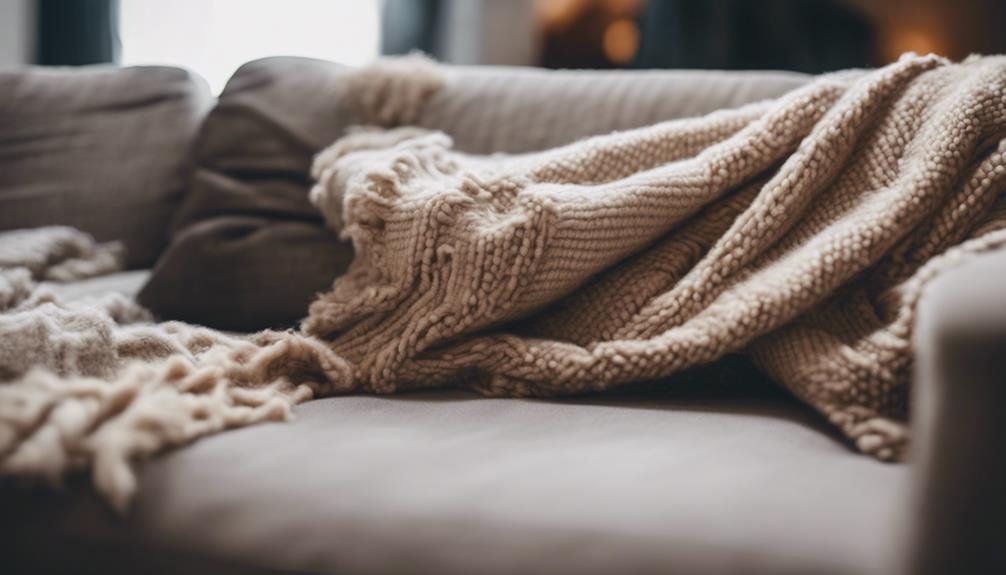
For maximum longevity in a couch throw blanket, wool emerges as the top choice due to its natural resilience and durability. Wool fibers are renowned for maintaining their shape and structure over time, making them ideal for frequent use on a couch.
The high-quality construction of wool blankets guarantees they can withstand regular washing and wear without losing their quality. Unlike other materials, wool blankets are less prone to pilling or shedding, providing a longer lifespan for a couch throw blanket.
By investing in a wool couch throw blanket, you can expect a durable and long-lasting addition to your living room decor. The natural properties of wool make it a reliable option for those seeking a throw blanket that will stand the test of time.
With its ability to resist wear and tear, wool is a practical choice for those looking for both quality and longevity in their couch throw blanket.
Maintaining Comfort and Durability
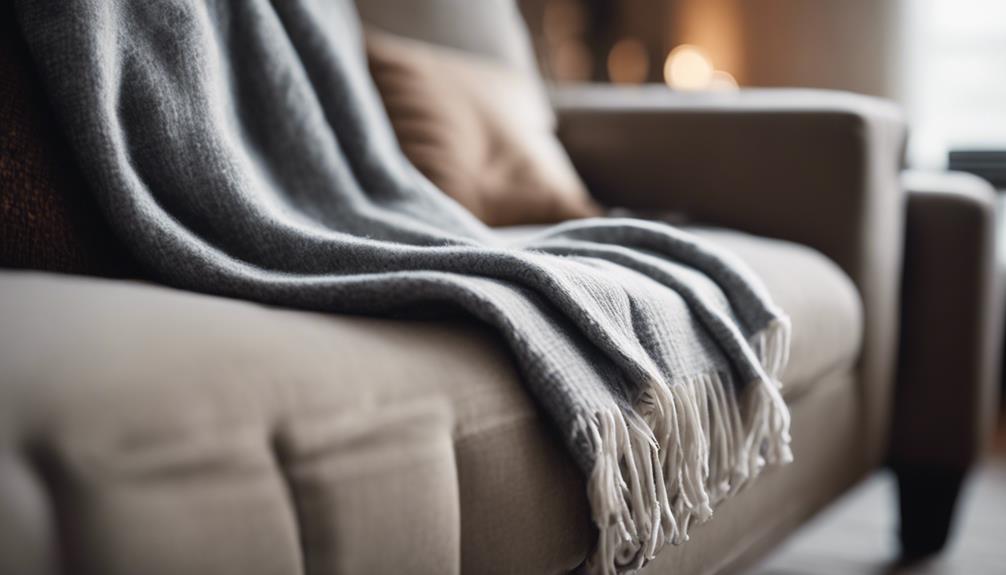
To guarantee both comfort and durability in a couch throw blanket, selecting a high-quality material such as cotton, wool, or fleece is essential. When choosing a throw blanket, consider the following:
- Cotton Throw Blankets: Opting for a cotton throw guarantees breathability, softness, and hypoallergenic properties, making it an ideal choice for cozying up on the couch.
- Wool Blankets: Wool throw blankets provide warmth, breathability, and natural fire resistance, ensuring long-lasting comfort and a cozy layer for your relaxation.
- Fleece Throw Blankets: If you're looking for a warm, sturdy, and wrinkle-resistant option, fleece throw blankets are a fantastic choice to add a snug layer to your couch.
Frequently Asked Questions
How to Choose a Throw Blanket for a Sofa?
When selecting a throw blanket for a sofa, consider its size and material. Make sure the blanket fits the couch and enhances the decor. Opt for materials like cotton, fleece, or acrylic for durability and easy maintenance.
Look for machine-washable options for convenience. Choose a soft and cozy material to add warmth and comfort to your sofa. Prioritize a material that complements your sofa fabric while being easy to care for.
What Is the Best Fabric for Throws?
When selecting the best fabric for throws, we must consider factors like softness, warmth, and durability. Various materials offer unique qualities that cater to different needs.
Cashmere provides luxury with its fine texture and insulation. Cotton stands out for breathability and durability, suitable for all seasons. Fleece blankets offer lightweight warmth and easy care. Mink materials give a plush feel at an affordable price. Berber Fleece combines lightweight warmth and softness.
What Is the Softest Material for a Throw?
When seeking the softest material for a throw, it's crucial to explore options like cashmere, faux fur, and plush fabrics. These materials offer a luxurious feel and gentle touch, perfect for cozying up on the couch.
Cashmere is known for its unmatched softness, while faux fur and plush fabrics provide a similar experience with added warmth. Choosing from these materials guarantees a comfortable and soothing throw blanket experience.
What Throws Are Best for Sofas?
When considering sofa throws, it's important to choose materials that balance warmth, durability, and style. Opt for fleece or faux fur for coziness, cotton blends for easy care, and cashmere for luxury. Berber fleece offers lightweight warmth, while size matters for proper sofa fit.
Select throws that match your sofa's style and provide the desired comfort level. Finding the best throw for your sofa involves considering material, size, and aesthetics.
Conclusion
To guarantee, to sum up, when selecting the best material for a couch throw blanket, it's crucial to take into account factors such as comfort, durability, and maintenance.
While fleece offers softness and warmth, sherpa material provides a cozy feel. Acrylic, nylon, and polyester are also viable options for those seeking longevity and easy care.
Ultimately, the best material for a couch throw blanket will depend on individual preferences and needs. Choose wisely to guarantee both comfort and durability in your home decor.
-

 Vetted7 months ago
Vetted7 months ago15 Best EMS Foot Massagers for Neuropathy to Soothe Your Feet
-
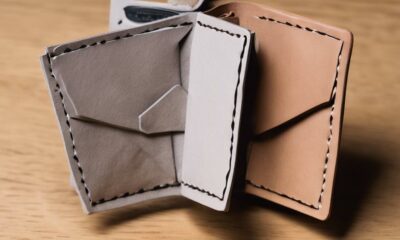
 Vetted7 months ago
Vetted7 months ago14 Best Personalized Father's Day Gifts for Your Husband – Show Him You Care
-

 Alfresco6 months ago
Alfresco6 months agoAlfresco Stacker Doors: Seamless Indoor-Outdoor Living!
-

 Tableware and Dining Accessories6 days ago
Tableware and Dining Accessories6 days agoWhat Is the Meaning of the Word Tableware
-

 Tableware and Dining Accessories6 days ago
Tableware and Dining Accessories6 days agoWhen Is Tableware on Sale at Hobby Lobby
-

 Tableware and Dining Accessories6 days ago
Tableware and Dining Accessories6 days agoWhich of the Following Is Not Classified as Tableware
-

 Craft and Textiles8 months ago
Craft and Textiles8 months ago15 Best Places to Buy Appliances for Your Home – Top Retailers Reviewed
-

 Vetted6 months ago
Vetted6 months agoBattle Born Batteries Review: Reliable Power Solution





























